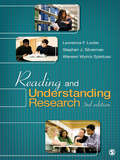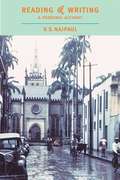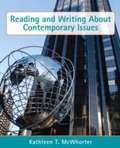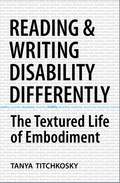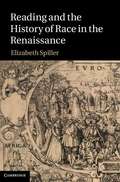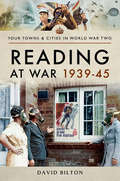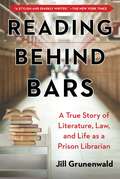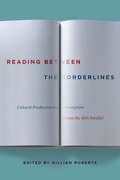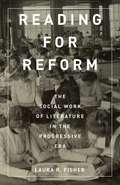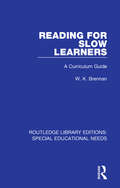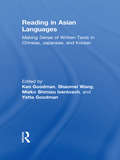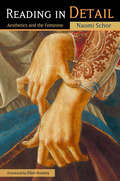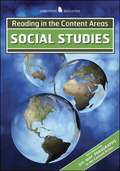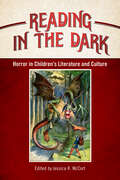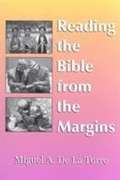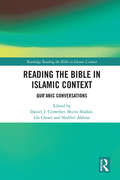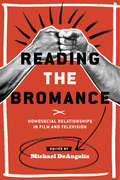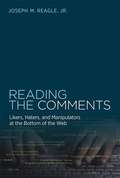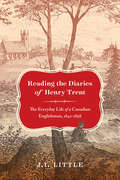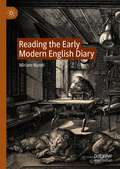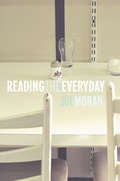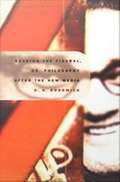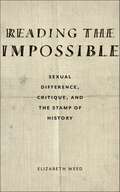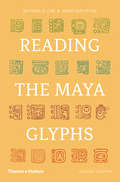- Table View
- List View
Reading and Understanding Research
by Lawrence F. Locke Waneen W. Spirduso Stephen SilvermanIdeal for students, novice researchers, or professionals, this indispensable resource serves as a road map for readers who need to analyze and apply research findings. It helps them think critically about the credibility of what they are reading by showing them how to identify problems and develop constructive questions.Key FeaturesAssumes no prior knowledge of research proceduresProvides readers with a step-by-step format for decoding the complex language and formats used in reports and reviewsIncludes the most common formats for both quantitative and qualitative inquiryOffers both illustrative examples and powerful training exercisesGives specific attention to strategies for critically appraising reported researchPresents completely updated references as well as an annotated bibliographyIntended AudienceThis text is appropriate for both upper-level undergraduate and graduate students across the social sciences enrolled in introductory research courses as well as students in professional preparation programs.
Reading and Writing
by V. S. NaipaulThe esteemed writer prepared this essay of literary autobiography, in which he discusses his personal development as a writer, for the Charles Douglas-Home Memorial Trust.
Reading and Writing About Contemporary Issues
by Kathleen T. McwhorterReading and Writing About Contemporary Issues offers an integrated approach to reading and writing using a handbook for reference and instruction followed by readings for analysis and writing.
Reading and Writing Disability Differently: The Textured Life of Embodiment
by Tanya TitchkoskyIn this study, Titchkosky analyzes the depiction of disabled people in the mass media. Through an examination of everyday texts such as news stories and government surveys, she uncovers and critiques a Western cultural assumption that sees disability as a clear-cut "problem" in need of a solution. Titchkosky (disability studies, U. of Toronto) is also the author of Disability, Self, and Society (2003). Annotation ©2007 Book News, Inc., Portland, OR (booknews.com)
Reading and the History of Race in the Renaissance
by Elizabeth SpillerElizabeth Spiller studies how early modern attitudes towards race were connected to assumptions about the relationship between the act of reading and the nature of physical identity. As reading was understood to happen in and to the body, what you read could change who you were. In a culture in which learning about the world and its human boundaries came increasingly through reading, one place where histories of race and histories of books intersect is in the minds and bodies of readers. Bringing together ethnic studies, book history and historical phenomenology, this book provides a detailed case study of printed romances and works by Montalvo, Heliodorus, Amyot, Ariosto, Tasso, Cervantes, Munday, Burton, Sidney and Wroth. Reading and the History of Race traces ways in which print culture and the reading practices it encouraged, contributed to shifting understandings of racial and ethnic identity.
Reading at War, 1939–45 (Towns & Cities in World War Two)
by David BiltonA history of life in the southern English town during World War II.As in the Great War, Reading in the Second World War was a town permanently in a state of flux. So close to London, so easily pinpointed by its proximity to the Thames, with railway lines converging near the town center and with much of the town’s industry geared up to essential war work, it was an obvious target for the German Luftwaffe when the war broke out. Knowing this, the council had set up an efficient civil defense system aided by government finance. Fortunately for the citizens, although they were bombed on many occasions, only one raid had any significant impact.The book covers the daily life of a town ready for the worst, but one that continued with its daily life and just got on with its efforts to aid the war effort. The book is profusely illustrated with photographs, illustrations and human interest stories. Much of the material used has not been seen since the war so it provides a valuable and unique insight into daily life of the town.“David Bilton takes an in-depth look at how the people of Reading coped during the conflict. Interesting to read that suffering from German Air Raids was apparently minimal, and the photographs, as always, are fascinating to see. A brilliant series.” —Books Monthly (UK)
Reading behind Bars: A True Story of Literature, Law, and Life as a Prison Librarian
by Jill GrunenwaldIn December 2008, twentysomething Jill Grunenwald graduated with her master’s degree in library science, ready to start living her dream of becoming a librarian. But the economy had a different idea. As the Great Recession reared its ugly head, jobs were scarce. After some searching, however, Jill was lucky enough to snag one of the few librarian gigs left in her home state of Ohio. The catch? The job was behind bars as the prison librarian at a men’s minimum-security prison. Talk about baptism by fire. As an untested twentysomething woman, to say that the job was out of Jill’s comfort zone was an understatement. She was forced to adapt on the spot, speedily learning to take the metal detectors, hulking security guards, and colorful inmates in stride. Over the course of a little less than two years, Jill came to see past the bleak surroundings and the orange jumpsuits and recognize the humanity of the men stuck behind bars. They were just like every other library patron—persons who simply wanted to read, to be educated and entertained through the written word. By helping these inmates, Jill simultaneously began to recognize the humanity in everyone and to discover inner strength that she never knew she had. At turns poignant and hilarious, Reading behind Bars is a perfect read for fans of Orange is the New Black and Shakespeare Saved My Life.
Reading between the Borderlines: Cultural Production and Consumption across the 49th Parallel
by Gillian RobertsIs Superman Canadian? Who decides, and what is at stake in such a question? How is the Underground Railroad commemorated differently in Canada and the United States, and can those differences be bridged? How can we acknowledge properly the Canadian labour behind Hollywood filmmaking, and what would that do to our sense of national cinema? Reading between the Borderlines grapples with these questions and others surrounding the production and consumption of literary, cinematic, musical, visual, and print culture across the Canada-US border. Discussing a range of popular as well as highbrow cultural forms, this collection investigates patterns of cross-border cultural exchange that become visible within a variety of genres, regardless of their place in any arbitrarily devised cultural hierarchy. The essays also consider the many interests served, compromised, or negated by the operations of the transnational economy, the movement of culture's "raw material" across nation-state borders in literal and conceptual terms, and the configuration of a material citizenship attributed to or negotiated around border-crossing cultural objects. Challenging the oversimplification of cultural products labelled either "Canadian" or "American," Reading between the Borderlines contends with the particularities and complications of North American cultural exchange, both historically and in the present.
Reading for Reform: The Social Work of Literature in the Progressive Era
by Laura R. FisherAn unprecedented examination of class-bridging reform and U.S. literary history at the turn of the twentieth century Reading for Reform rewrites the literary history of late nineteenth and early twentieth century America by putting social reform institutions at the center of literary and cultural analysis. Examining the vibrant, often fractious literary cultures that developed as part of the Progressive mandate to uplift the socially disadvantaged, it shows that in these years reformers saw literature as a way to combat the myriad social problems that plagued modern U.S. society. As they developed distinctly literary methods for Americanizing immigrants, uplifting and refining wage-earning women, and educating black students, their institutions gave rise to a new social purpose for literature.Class-bridging reform institutions—the urban settlement house, working girls&’ club, and African American college—are rarely addressed in literary history. Yet, Laura R. Fisher argues, they engendered important experiments in the form and social utility of American literature, from minor texts of Yiddish drama and little-known periodical and reform writers to the fiction of Edith Wharton and Nella Larsen. Fisher delves into reform&’s vast and largely unexplored institutional archives to show how dynamic sites of modern literary culture developed at the margins of social power. Fisher reveals how reformist approaches to race, class, religion, and gender formation shaped American literature between the 1880s and the 1920s. In doing so, she tells a new story about the fate of literary practice, and the idea of literature&’s practical value, during the very years that modernist authors were proclaiming art&’s autonomy from concepts of social utility.
Reading for Slow Learners: A Curriculum Guide (Routledge Library Editions: Special Educational Needs #5)
by W. K. BrennanFirst published in 1978. Reading for Slow Learners is a practical guide for teachers, defining the objectives of the reading curriculum, identifying important aspects of teaching method and suggesting various approaches. This title will also be of interest to parents of children with learning difficulties.
Reading in Asian Languages: Making Sense of Written Texts in Chinese, Japanese, and Korean
by Yetta Goodman Ken Goodman Shaomei Wang Mieko Shimizu IventoschReading in Asian Languages is rich with information about how literacy works in the non-alphabetic writing systems (Chinese, Japanese, Korean) used by hundreds of millions of people and refutes the common Western belief that such systems are hard to learn or to use. The contributors share a comprehensive view of reading as construction of meaning which they show is fully applicable to character-based reading. The book explains how and why non-alphabetic writing works well for its users; provides explanations for why it is no more difficult for children to learn than are alphabetic writing systems where they are used; and demonstrates in a number of ways that there is a single process of making sense of written language regardless of the orthography. Unique in its perspective and offering practical theory-based methodology for the teaching of literacy in Chinese, Japanese, and Korean to first and second language learners, it is a useful resource for teachers of increasingly popular courses in these languages in North America as well as for teachers and researchers in Asia. It will stimulate innovation in both research and instruction.
Reading in Detail: Aesthetics and the Feminine
by Naomi SchorWho cares about details? As Naomi Schor explains in her highly influential book, we do-but it has not always been so. The interest in detail--in art, in literature, and as an aesthetic category--is the product of the decline of classicism and the rise of realism.But the story of the detail is as political as it is aesthetic. Secularization, the disciplining of society, the rise of consumerism, the invention of the quotidian, have all brought detail to the fore. In this classic work of aesthetic and feminist theory, now available in a new paperback edition, Schor provides ways of thinking about details and ornament in literature, art, and architecture, and uncovering the unspoken but powerful ideologies that attached gender to details. Wide-ranging and richly argued, Reading in Detail presents ideas about reading (and viewing) that will enhance the study of literature and the arts.
Reading in the Content Areas: Social Studies
by McGraw-Hill Education StaffBased on the best-selling Six-Way Paragraphs books, these individual titles help students master the essential skills needed to organize, understand, and apply information in math, science, and social studies. Here are the books that will open doors for you into your content area classrooms.
Reading in the Dark: Horror in Children's Literature and Culture (Children's Literature Association Series)
by Jessica R. McCortContributions by Rebecca A. Brown, Justine Gieni, Holly Harper, Emily L. Hiltz, A. Robin Hoffman, Kirsten Kowalewski, Peter C. Kunze, Jorie Lagerwey, Nick Levey, Jessica R. McCort, and Janani SubramanianDark novels, shows, and films targeted toward children and young adults are proliferating wildly. It is even more crucial now to understand the methods by which such texts have traditionally operated and how those methods have been challenged, abandoned, and appropriated. Reading in the Dark fills a gap in criticism devoted to children's popular culture by concentrating on horror, an often-neglected genre. These scholars explore the intersection between horror, popular culture, and children's cultural productions, including picture books, fairy tales, young adult literature, television, and monster movies.Reading in the Dark looks at horror texts for children with deserved respect, weighing the multitude of benefits they can provide for young readers and viewers. Refusing to write off the horror genre as campy, trite, or deforming, these essays instead recognize many of the texts and films categorized as "scary" as among those most widely consumed by children and young adults. In addition, scholars consider how adult horror has been domesticated by children's literature and culture, with authors and screenwriters turning that which was once horrifying into safe, funny, and delightful books and films. Scholars likewise examine the impetus behind such re-envisioning of the adult horror novel or film as something appropriate for the young. The collection investigates both the constructive and the troublesome aspects of scary books, movies, and television shows targeted toward children and young adults. It considers the complex mechanisms by which these texts communicate overt messages and hidden agendas, and it treats as well the readers' experiences of such mechanisms.
Reading the Bible From the Margins
by Miguel A. De La TorreDescribing how "standard" readings of the Bible are not always acceptable to people or groups on the "margins," this book afters valuable new insights into biblical texts today.
Reading the Bible in Islamic Context: Qur'anic Conversations (Routledge Reading the Bible in Islamic Context Series)
by Shirin Shafaie Shabbir Akhtar Daniel J Crowther Ida GlaserIn the current political and social climate, there is increasing demand for a deeper understanding of Muslims, the Qur’an and Islam, as well as a keen demand among Muslim scholars to explore ways of engaging with Christians theologically, culturally, and socially. This book explores the ways in which an awareness of Islam and the Qur’an can change the way in which the Bible is read. The contributors come from both Muslim and Christian backgrounds, bring various levels of commitment to the Qur’an and the Bible as Scripture, and often have significantly different perspectives. The first section of the book contains chapters that compare the report of an event in the Bible with a report of the same event in the Qur’an. The second section addresses Muslim readings of the Bible and biblical tradition and looks at how Muslims might regard the Bible - Can they recognise it as Scripture? If so, what does that mean, and how does it relate to the Qur’an as Scripture? Similarly, how might Christian readers regard the Qur’an? The final section explores different analogies for understanding the Bible in relation to the Qur’an. The book concludes with a reflection upon the particular challenges that await Muslim scholars who seek to respond to Jewish and Christian understandings of the Jewish and Christian scriptures. A pioneering venture into intertextual reading, this book has important implications for relationships between Christians and Muslims. It will be of significant value to scholars of both Biblical and Qur’anic Studies, as well as any Muslim seeking to deepen their understanding of the Bible, and any Christian looking to transform the way in which they read the Bible.
Reading the Bromance: Homosocial Relationships in Film and Television
by Michael DeangelisIn the middle of this century's first decade, "bromance" emerged as a term denoting an emotionally intense bond between straight men. Yet bromance requires an expression of intimacy that always toys with being coded as something other than "straight" male behavior, even as it insists that such intimacy must never be misinterpreted. In Reading the Bromance: Homosocial Relationships in Film and Television, editor Michael DeAngelis has compiled a diverse group of essays that address the rise of this tricky phenomenon and explore the social and cultural functions it serves. Contributors consider selected contemporary film and television texts, as well as the genres that historically inspired them, in order to explore what needs bromance attempts to fulfill in relationships between men--straight or otherwise. Essays analyze films ranging from I Love You, Man to Superbad, Humpday, I Now Pronounce You Chuck and Larry, The Hangover, and the Jackass films, and include studies of representative examples in international cinema such as Y tu mama tambien and classic and contemporary films of the Bollywood genre. The volume also examines the increasingly prevalent appearance of the bromance phenomenon in television narratives, from the "male bonding" rituals of Friends and Seinfeld to more recent manifestations in House, The Wire, and the MTV reality series Bromance. From historical analysis to discourse analysis, sociological analysis, and queer theory, this volume provides a broad range of methodological and theoretical approaches to the phenomenon in the first booklength study of the bromance genre. Film and television scholars as well as readers interested in pop culture and queer studies will enjoy the insights of Reading the Bromance.
Reading the Comments
by Joseph M. ReagleOnline comment can be informative or misleading, entertaining or maddening. Haters and manipulators often seem to monopolize the conversation. Some comments are off-topic, or even topic-less. In this book, Joseph Reagle urges us to read the comments. Conversations "on the bottom half of the Internet," he argues, can tell us much about human nature and social behavior.Reagle visits communities of Amazon reviewers, fan fiction authors, online learners, scammers, freethinkers, and mean kids. He shows how comment can inform us (through reviews), improve us (through feedback), manipulate us (through fakery), alienate us (through hate), shape us (through social comparison), and perplex us. He finds pre-Internet historical antecedents of online comment in Michelin stars, professional criticism, and the wisdom of crowds. He discusses the techniques of online fakery (distinguishing makers, fakers, and takers), describes the emotional work of receiving and giving feedback, and examines the culture of trolls and haters, bullying, and misogyny. He considers the way comment -- a nonstop stream of social quantification and ranking -- affects our self-esteem and well-being. And he examines how comment is puzzling -- short and asynchronous, these messages can be slap-dash, confusing, amusing, revealing, and weird, shedding context in their passage through the Internet, prompting readers to comment in turn, "WTF?!?"
Reading the Comments: Likers, Haters, and Manipulators at the Bottom of the Web (The\mit Press Ser.)
by Joseph M. ReagleWhat we can learn about human nature from the informative, manipulative, confusing, and amusing messages at the bottom of the web.Online comment can be informative or misleading, entertaining or maddening. Haters and manipulators often seem to monopolize the conversation. Some comments are off-topic, or even topic-less. In this book, Joseph Reagle urges us to read the comments. Conversations “on the bottom half of the Internet,” he argues, can tell us much about human nature and social behavior.Reagle visits communities of Amazon reviewers, fan fiction authors, online learners, scammers, freethinkers, and mean kids. He shows how comment can inform us (through reviews), improve us (through feedback), manipulate us (through fakery), alienate us (through hate), shape us (through social comparison), and perplex us. He finds pre-Internet historical antecedents of online comment in Michelin stars, professional criticism, and the wisdom of crowds. He discusses the techniques of online fakery (distinguishing makers, fakers, and takers), describes the emotional work of receiving and giving feedback, and examines the culture of trolls and haters, bullying, and misogyny. He considers the way comment—a nonstop stream of social quantification and ranking—affects our self-esteem and well-being. And he examines how comment is puzzling—short and asynchronous, these messages can be slap-dash, confusing, amusing, revealing, and weird, shedding context in their passage through the Internet, prompting readers to comment in turn, “WTF?!?”
Reading the Diaries of Henry Trent: The Everyday Life of a Canadian Englishman, 1842-1898 (McGill-Queen's Rural, Wildland, and Resource Studies)
by J.I. LittleThe personal journals examined in Reading the Diaries of Henry Trent are not the witty, erudite, and gracefully written exercises that have drawn the attention of most biographers and literary scholars. Prosaic, ungrammatical, and poorly spelled, the fifteen surviving volumes of Henry Trent's hitherto unexamined diaries are nevertheless a treasure for the social and cultural historian.Henry Trent was born in England in 1826, the son of a British naval officer. When he was still a boy, his father decided to begin a new life as a landed gentleman and moved the family to Lower Canada. At the age of sixteen Trent began writing in a diary, which he maintained, intermittently, for more than fifty years. As a lonely youth he narrates days spent hunting and trapping in the woods owned by his father. On the threshold of manhood and in search of a vocation, he writes about his experiences in London and then on Vancouver Island during the gold rush. And finally, as the father of a large family, he describes the daily struggle to make ends meet on the farm he inherited in Quebec's lower St Francis valley.As it follows Trent through the different stages of his long life, Reading the Diaries of Henry Trent explores the complexities of class and colonialism, gender roles within the rural family, and the transition from youth to manhood to old age. The diaries provide a rare opportunity to read the thoughts and follow the experiences of a man who, like many Victorian-era immigrants of the privileged class, struggled to adapt to the Canadian environment during the rise of the industrial age.
Reading the Early Modern English Diary
by Miriam NandiReading the Early Modern Diary traces the historical genealogy, formal characteristics, and shifting cultural uses of the early modern English diary. It explores the possibilities and limitations the genre held for the self-expression of a writer at a time which considerably pre-dated the Romantic cult of the individual self. The book analyzes the connections between genre and self-articulation: How could the diary come to be associated with emotional self-expression given the tedium and repetitiveness of its early seventeenth-century ancestors? How did what were once mere lists of daily events evolve into narrative representations of inner emotions? What did it mean to write on a daily basis, when the proper use of time was a heavily contested issue? Reading the Early Modern Diary addresses these questions and develops new theoretical frameworks for discussing interiority and affect in early modern autobiographical texts.
Reading the Everyday
by Joe MoranIn an ever-growing field of study, this is a major contribution to one of the key areas in cultural studies and cultural theory – the spaces, practices and mythologies of our everyday culture. Drawing on the work of such continental theorists as Henri Lefebvre, Michel de Certeau, Marc Augé and Siegfried Kracauer, Joe Moran explores the concrete sites and routines of everyday life and how they are represented through political discourse, news media, material culture, photography, reality TV shows, CCTV and much more. Unique in his focus of the under-explored, banal aspects of everyday culture, including office life, commuting, traffic and mass housing, Moran re-evaluates conventional notions of everyday life in cultural studies, and shows that analysing such ‘boring’ phenomena can help make sense of cultural and social change. This book is interdisciplinary in its approach and covers many different areas including visual culture, cultural geography, material culture, and cultural history as well as the key areas of cultural studies and sociology. Students from all these subjects will find this clearly written and lively work an invaluable study resource.
Reading the Figural: Or, Philosophy After the New Media
by D. N. RodowickIn Reading the Figural, or, Philosophy after the New Media D. N. Rodowick applies the concept of "the figural" to a variety of philosophical and aesthetic issues. Inspired by the aesthetic philosophy of Jean-Franois Lyotard, the figural defines a semiotic regime where the distinction between linguistic and plastic representation breaks down. This opposition, which has been the philosophical foundation of aesthetics since the eighteenth century, has been explicitly challenged by the new electronic, televisual, and digital media. Rodowick--one of the foremost film theorists writing today--contemplates this challenge, describing and critiquing the new regime of signs and new ways of thinking that such media have inaugurated. To fully comprehend the emergence of the figural requires a genealogical critique of the aesthetic, Rodowick claims. Seeking allies in this effort to deconstruct the opposition of word and image and to create new concepts for comprehending the figural, he journeys through a range of philosophical writings: Thierry Kuntzel and Marie-Claire Ropars-Wuilleumier on film theory; Jacques Derrida on the deconstruction of the aesthetic; Siegfried Kracauer and Walter Benjamin on the historical image as a utopian force in photography and film; and Gilles Deleuze and Michel Foucault on the emergence of the figural as both a semiotic regime and a new stratagem of power coincident with the appearance of digital phenomena and of societies of control. Scholars of philosophy, film theory, cultural criticism, new media, and art history will be interested in the original and sophisticated insights found in this book.
Reading the Impossible: Sexual Difference, Critique, and the Stamp of History
by Elizabeth WeedReading the impossible has never seemed less possible. A few decades ago, critical readings could view the collapse of foundationalism optimistically. With meaning no longer soldered onto being, there was hope for all those beings whose meaning had been forever ordained by Nature or the Divine. Critical reading thus became a way of exploring the devious workings of knowledge and power. But as non-foundational systems of meaning have proven to be so perfectly suited to the transactional logics of the market, reading for the impasses of meaning has come to be seen as quixotic, impractical, and dated. To concur with that view, Elizabeth Weed argues, is to embrace the fantasy told by the neoliberal order. To read the impossible is to disrupt that fantasy, with its return to stable categories of marketable identity, in order to contest the inexorable workings of misogyny and racism. This book seeks to disturb the positivity of identity in the hope of retrieving the impossibility of sexual difference, an impossibility that has its effects in the Real of misogyny.A return to the famous debate between Derrida and Lacan on the impossibility of sexual difference yields two different readings of the impossible. In reconsidering these questions, Weed shows how the practice of reading can powerfully stage the wiles of language and the unconscious. In returning to that earlier moment in the context of current debates on the role of reading and interpretation, Weed offers a fresh perspective on what is at stake for critical reading in the neoliberal university.
Reading the Maya Glyphs (Second Edition)
by Michael D. Coe Mark Van StoneThe breaking of the Maya code has completely changed our knowledge of this ancient civilization, and has revealed the Maya people's long and vivid history. Decipherment of Maya hieroglyphic writing has progressed to the point where most Maya written texts—whether inscribed on monuments, written in the codices, or painted or incised on ceramics—can now be read with confidence. In this practical guide, first published in 2001, Michael D. Coe, the noted Mayanist, and Mark Van Stone, an accomplished calligrapher, have made the difficult, often mysterious script accessible to the nonspecialist. They decipher real Maya texts, and the transcriptions include a picture of the glyph, the pronunciation, the Maya words in Roman type, and the translation into English. For the second edition, the authors have taken the latest research and breakthroughs into account, adding glyphs, updating captions, and reinterpreting or expanding upon earlier decipherments. After an introductory discussion of Maya culture and history and the nature of the Maya script, the authors introduce the glyphs in a series of chapters that elaborate on topics such as the intricate calendar, warfare, royal lives and rituals, politics, dynastic names, ceramics, relationships, and the supernatural world. The book includes illustrations of historic texts, a syllabary, a lexicon, and translation exercises.
